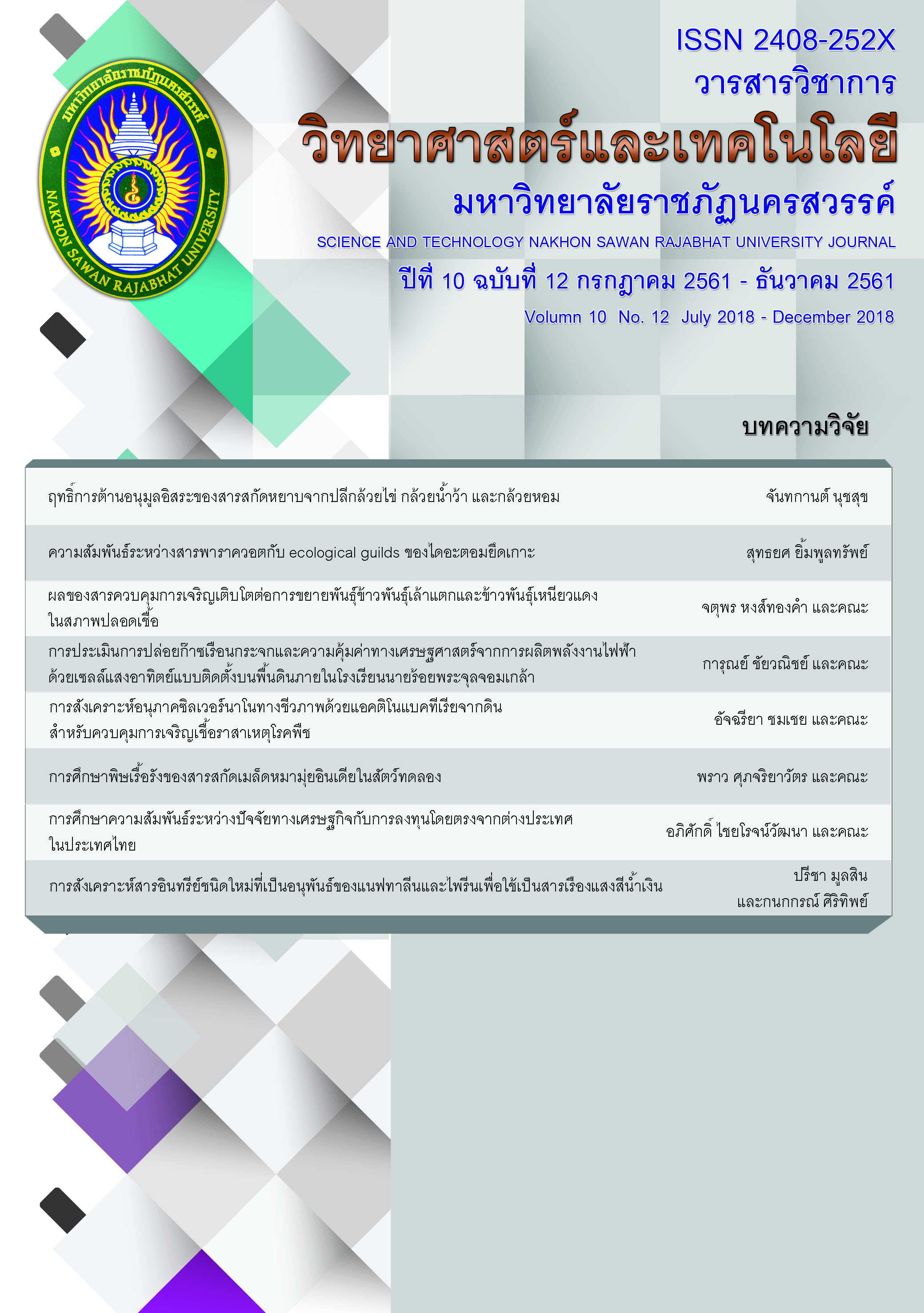ความสัมพันธ์ระหว่างสารพาราควอตกับ ecological guilds ของไดอะตอมยึดเกาะ
Main Article Content
Abstract
ศึกษาความสัมพันธ์ระหว่างสารพาราควอตกับ ecological guilds ของไดอะตอมยึดเกาะในชุดทดลองขนาดเล็ก โดยนำกระเบื้องเซรามิคขนาด 10*10 ตารางเซนติเมตร ไปวางขวางลำน้ำแม่แคมที่ความลึก 30 เซนติเมตร เป็นเวลา 4 สัปดาห์ ในเดือนพฤษภาคม 2556 ที่สะพานบ้านนาคูหา ตำบล สวนเขื่อน อำเภอเมืองแพร่ จังหวัดแพร่ ซึ่งเป็นแหล่งน้ำไหลบริเวณต้นน้ำ จากนั้นเก็บตัวอย่างน้ำและกระเบื้องเซรามิคที่มีไดอะตอมยึดเกาะมาทดลองในชุดทดลอง จำนวน 6 ชุดทดลอง แต่ละชุดทดลองได้รับสัมผัสสารพาราควอตที่ความเข้มข้นเริ่มต้น 6 ความเข้มข้น ได้แก่ 0.00, 0.03, 0.28, 2.76, 27.60 และ 276.00 มิลลิกรัมต่อลิตร ทิ้งไว้เป็นเวลา 6 วัน วัดความหนาแน่นสัมพัทธ์ (ร้อยละ) ของไดอะตอมยึดเกาะกลุ่ม low – profile, high – profile และ motile ทุกวัน พบว่า ecological guilds ของไดอะตอมยึดเกาะสามารถประเมินการปนเปื้อนของสารพาราควอตในแหล่งน้ำได้ โดยความหนาแน่นสัมพัทธ์ของไดอะตอมยึดเกาะกลุ่ม low – profile จะมีความหนาแน่นสัมพัทธ์สูงขึ้นเมื่อได้รับสัมผัสสารพาราควอตในความเข้มข้นที่เพิ่มขึ้น ในขณะที่ไดอะตอมยึดเกาะกลุ่ม high – profile มีแนวโน้มความหนาแน่นสัมพัทธ์ต่ำลงเมื่อได้รับสัมผัสสารพาราควอต ส่วนความหนาแน่นสัมพัทธ์ของไดอะตอมยึดเกาะกลุ่ม motile มีแนวโน้มต่ำลงเล็กน้อยเมื่อได้รับสัมผัสสารพาราควอต ซึ่งความหนาแน่นสัมพัทธ์ที่สูงขึ้นและต่ำลงของไดอะตอมยึดเกาะทั้ง 3 กลุ่ม สามารถนำไปประเมินการปนเปื้อนของสารพาราควอตในแหล่งน้ำได้
Article Details
References
ชุมพล คนศิลป์, และอุทัย ฤทธิแสง. (2537). การทดสอบการใช้แถบหญ้าและคันดินกั้นน้ำป้องกันการชะล้างพังทลายของดิน. สำนักงานพัฒนาที่ดินเขต 5 กรมพัฒนาที่ดิน กระทรวงเกษตรและสหกรณ์, กรุงเทพฯ.
ฝ่ายวัตถุมีพิษ สำนักงานควบคุมพืชและวัสดุการเกษตร กรมวิชาการเกษตร. (2560). วัตถุอันตรายที่มีการนำเข้าสูงสุด 10 อันดับแรก ปี 2559. กรมวิชาการเกษตร, กรุงเทพฯ.
พรชัย เหลืองอาภาพงษ์. (2540). วัชพืชศาสตร์. ภาควิชาพืชไร่ คณะเกษตรศาสตร์ มหาวิทยาลัยเชียงใหม่, เชียงใหม่.
ยุวดี พีรพรพิศาล. (2546). สาหร่ายวิทยา. ภาควิชาชีววิทยา คณะวิทยาศาสตร์ มหาวิทยาลัยเชียงใหม่, เชียงใหม่.
Debenest, T., Pinelli, E., Coste, M., Silvestre, J., Mazzella, N., Madigou, C., et al. (2009). “Sensitivity of freshwater periphytic diatoms to agricultural herbicides”. Aquatic Toxicology, 9(1), 11-7.
Food and Agriculture Organization of the United Nations. (2008). Specifications and evaluations for agricultural pesticides, paraquat dichloride 1,1´-dimethyl-4,4´-bipyridinium dichloride. Organization, Rome.
Johnson, R.E., Tuchman, N.C. & Peterson, C.G. (1997). “Changes in the vertical microdistribution of diatoms within a developing periphyton mat”. Journal of the North American Benthological Society, 16, 503-519.
Kuntom, A., Kifli, H. & Tan, Y.A. (1999). “Method for the determination of paraquat residue in oil matrix”. Journal of Oil Palm Research, 2(2), 57-62.
Miller, G.T. (2005). Essential of ecology. Thomson Learning, California.
Passy, S.I. (2007). “Diatom ecological guilds display distinct and predictable behavior along nutrient and disturbance gradients in running waters”. Aquatic botany, 171-178.
Pekthong, T. (2002). Biodiversity of benthic diatoms and their application in monitoring water quality of Mae Sa Stream, Doi Suthep – Pui National Park Chiang Mai. Dissertation doctor of Philosophy in biology, Chiang Mai University.
Pringle, C.M. (1990). “Nutrient spatial heterogeneity: effects on community structure, physiognomy, and diversity of stream algae”. Ecology. 71, 905-920.
Rimet, F. & Bouchez, A. (2011). “Use of diatom life-forms and ecological guilds to assess pesticide contamination in rivers: Lotic mesocosm approaches”. Ecological Indicators, 11, 489-499.
Roubeix, V., Mazzella, N., Schouler, L., Fauvelle, V., Morin, S., Coste, M., et al. (2011). “Variations of periphytic diatom sensitivity to the herbicide diuron and relation to species distribution in contamination gradient: implications for biomonitoring”. Journal of Environmental Monitoring, 13, 1768.
Watts, M. (2011). Paraquat. Pesticide Action Network Asia and The Pacific, Penang.
Yamada, Y. (2014). Paraquat. Tsukuba: National Food Research Institute. Available from: http://www.fao.org/fileadmin/.../paraquat.pdf. cited 2014 Jul 24.


